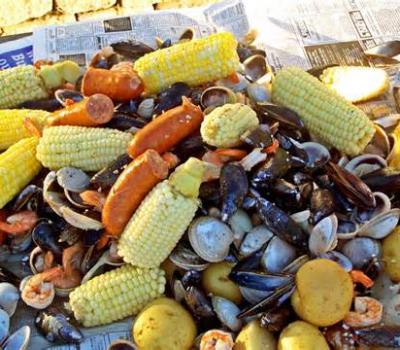All tags
5 star recipes
A
air fry
alcohol beverages
Beverages
BREADS
Breakfast
cakes
Candy
Casseroles
charcuterie boards
Chicken
chili
Chinese
Chowder
Christmas
coffee cakes
Conversion Chart
cookies
dale.
DESSERTS
DIPS
easter
fish
Freezer Meals
Friends
Halloween
herbs/spices
jan's canning
jan's ice cream
meat
Mexican
MISC
Muffins
new years
pasta
Pastry
Pies
polish
Potatoes
potpourri
pressure canner
QUICK BREADS
Rice
Salad Dressings
SALADS
sandwich spreads
Sandwiches
Seafood
Skillet
SNACKS
Soup
st. patrick
Stews
summer
t
Thanksgiving
Vegetables

Clam Bake
Ingredients
A classic New England clambake includes lobsters, clams, corn and potatoes often with the addition of chicken, sausage, mussels and onions, all placed in layers alternating with seaweed and cooked for several hours on the beach in a canvas (no rubberized or synthetic materials, please) tarp-covered, rock-lined pit. The ingredients that take the longest to cook—such as potatoes and onions—are placed closest to the heat source, while the fast-cooking items are placed on top.Known as a lobster bake in Maine, this earthy, elaborate meal is the ultimate shoreline feast. When gathering your equipment, look for rockweed—it's the best seaweed for clambakes because its seawater-filled pockets burst during cooking and add brininess and moisture to the other ingredients. In a pinch, try buying rockweed from your fishmonger; it's used to pack shellfish and is often abundant where seafood is sold. If necessary, you can keep it fresh for two to three days by packing it in a large container with an equal amount of salted water.
Ingredients
■3 pounds small boiling potatoes or medium sweet potatoes, cut in half
■8 quarts littleneck or cherrystone clams
■12 ears corn, husks on
■2 pounds red or yellow onions, peeled and cut in half
■8 quarts mussels, well-rinsed and debearded
■12 chicken thighs (optional)
■3 pounds spicy sausage such as chorizo, linguica,
kielbasa or andouille, cut into 4-inch lengths
■12 (1-1¼ pound) lobsters, live
■6 sticks butter, melted
■Lemon wedges
Additional equipment:
■Several bushels of seaweed, preferably rockweed, well rinsed
■Enough driftwood or cordwood to build a large fire, 15-20 rocks, each about the size of a football
■Approximately 50 feet of cheesecloth (you may use less but it's better to have plenty on hand)
■1 bucket seawater
■1 large canvas tarp soaked in sea water
■Additional stones and sand to weight the tarp down
Nothing beats lemon-and-butter-drenched seafood consumed at the water's edge, and guests hungrily applauded as lobsters, clams, mussels and vegetables were pulled from the pit and passed around. For dessert, I stuck with a simple finale of watermelon, fruit pie and brownies. As night fell, encroaching dark coaxed our circle closer around the glowing embers. One by one, after a surfeit of s'mores, the younger children fell asleep. The rest of us weighed the pros and cons of the waning summer and made vague plans for the one to come. By the time we threw water on the coals, it was always past midnight
Instructions
1. At least 5 hours before you plan to eat, dig a pit on the beach about 2 feet wide, 2 feet deep and 3 feet long. Line bottom of pit with large stones. Use driftwood or cordwood to build a fire on top of stones. Feed the fire and keep it going 1½-2 hours, or until stones are red-hot. Let fire burn down until all wood has burned to coals and ashes, about 2 hours more.2. Meanwhile, wrap each component—except lobsters, butter and lemon wedges—in a triple layer of cheesecloth so they form flat packages. When fire has turned to all coals, cover stones with a 6-inch layer of seaweed. Stack packages of potatoes, clams, corn, onions, mussels, chicken and sausage—in that order—on top of stones and seaweed, separating each layer with a thin layer of seaweed. Top with lobsters and a final 4-inch layer of seaweed.
3. Pour 2 quarts seawater over seaweed and cover pit with water-soaked tarp. Pile stones and a layer of sand along edges of the tarp to hold it down and prevent steam from escaping.
4. After 1½ hours, carefully and using long tongs, pull out a lobster and check to see if it is cooked. If it is, the clambake is ready. If not, check every half hour until it is. Remove cheesecloth packages and lobsters from pit and unwrap. Divide among diners and serve with lots of melted butter and lemon wedges.
MY NOTES